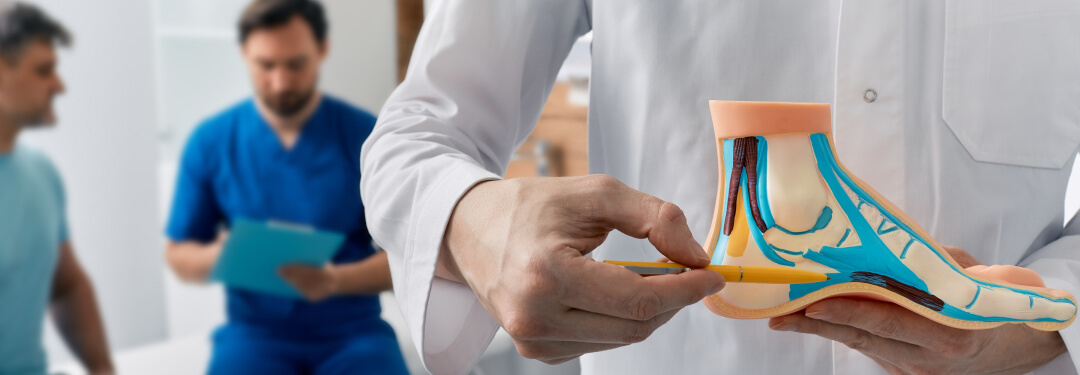New technologies are delivering big benefits for podiatrists and their patients
Healthcare technology is evolving rapidly, with new tools and solutions promising to help improve care while minimizing the manual work needed to run your practice efficiently and effectively.
At the same time, patients are demanding a more digital experience –– research shows that 26% of patients are willing to switch to a new provider for high-quality digital services.1 Your patients are becoming more tech savvy, and they’ve come to expect a certain level of tech literacy from their providers as well. After all, the right healthcare technology can save clinicians and patients time, drive business efficiencies, and help foster better patient engagement. When patients receive high-quality care, supplemented by the digital experiences they’ve come to expect, they’re more likely to stay with your practice.
That’s why podiatrists need to adopt the new technologies already making waves across healthcare. Let’s look at four ways you can use new healthcare technology to improve patient care, increase efficiency, and achieve your business goals.
Select a comprehensive EHR with podiatry-specific workflows and content
Your EHR is your primary technology tool for operating your practice. It’s important that the EHR you select is not only a well-rounded suite of solutions and services, but is also well-suited for podiatrists’ specific needs.
In part, this means you should look for an EHR platform that makes customization and configurability a priority. Ideally, your EHR will come loaded with pre-built workflows that have been calibrated to your most common patient encounters. And, you should have the ability to make adjustments from there to ensure your technology is in service of your approach to care (not the other way around).
The right EHR will also provide you with quick access to clinical content that's useful and engaging for your patients, which will allow you to deliver additional value for your patients and keep in touch with them between visits.
Another characteristic of a leading EHR is that it is updated frequently and seamlessly. For instance, many EHR platforms are now built using cloud technology, meaning software fixes and upgrades can be delivered quickly, and without causing disruption to your practice or your patients.
Free up the front-office using digital tools
Technology tools in the front office can help improve the quality-of-care delivery, too. Front-office staff are often overloaded with tasks that technology can streamline –– meaning they have less time available to focus on the tasks related to patient care.
Your organization can benefit from offering digital check-in, patient self-scheduling, or digital payments through the patient portal. These options also tend to increase patient satisfaction, loyalty, and retention by appealing to patients’ desire for a tech-enabled, streamlined healthcare experience. Not only are they less time-consuming for patients, but they meet patients where they are: on their phones.
Digital tools in the front office enable administrative staff to focus on the tasks that keep patients healthy and grow your business. After implementing digital check-in, one healthcare organization found that their staff finally had time to run the reports needed to make sure that patients in value-based contracts aren’t falling through the cracks.
Another practice reported that self-scheduling allows them to fill their schedule more efficiently and has led to fewer no-shows. When patients are getting the high-quality care they need, through an experience that’s convenient to them, they’ll keep coming back. And that’s a win-win for everyone, including your business.
Coordinate care and close care gaps using interoperability
When it comes to sharing patient data across care settings and members of a care team, technology plays a key role. Raw data exchange is table stakes today — but more data isn’t always better. How can providers synthesize patient data to give clinicians the information they need, when they need it?
You can start by choosing an EHR that not only provides high-quality data access and data exchange, but also emphasizes intuitive interoperability — surfacing the most relevant information during the encounter itself.
Think about care gap closure, for example. Picture your EHR flagging information about a care gap, gleaned from data exchange with a patient’s recent urgent care visit, that you can close during that encounter. When information is served up at the right moment, that can save time for both you and the patient, prevent more complex, costly care down the line, and increase reimbursement in value-based contracts.
Also, remember that referrals play a crucial role in your business model. An EHR is that is already connected to a variety of providers in your area can also make the referral process more seamless.
Use automation to maximize your time with patients
Automation and artificial intelligence tools in healthcare are largely aimed at minimizing administrative work for clinicians, so you can do what you do best: provide patient care. AI can predict the most likely action a clinician would take based on an inbox item in the EHR and make that a “one click” action at the top of the list.
AI technologies help create more efficient workflows, giving you back time to devote to patients. Rather than looking at the computer during the encounter, you might dictate your documentation notes or use AI-powered voice navigation to move through EHR workflows. Some AI tools now offer the ability to listen to a patient encounter and generate their own notes, so all that’s left is reviewing and signing off on documentation work.
These options free you up to focus on the patient and their care plan. And with more time back in your day, you have the opportunity to expand appointment availability, increase appointment length, or even invest in priority initiatives that help drive your organization’s bottom line.
The future of healthcare tech and podiatry
No two healthcare organizations are exactly alike in their technology needs, but these four categories are a great place to start. With the right podiatry EHR software, you’ll be able to take even better care of your patients while unearthing new time for business initiatives.
As healthcare technology continues to evolve, there will likely be new tools that meet the specific needs of your business. And as your business grows, it will be critical to continue leveraging new technologies in order to drive efficiency and save time. Get started today — and lay the foundation for future success.
Want to learn more? See how athenahealth supports the unique needs of healthcare specialties.
More EHR usability resources
Continue exploring
- Accenture, August 2020, How can leaders make recent digital health gains last?












